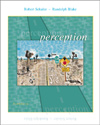| adaptation | A reduction in the responsiveness of neurons, produced by prolonged stimulation.
|
 |
 |
 |
| ambiguity problem | Because several stimulus variables jointly determine the response of any sensory neuron, a single neuron's response is ambiguous with respect to stimulus conditions.
|
 |
 |
 |
| binocular | Seeing with two eyes. See monocular.
|
 |
 |
 |
| binocular cell | A visual cortical cell receiving excitatory input from both eyes.
|
 |
 |
 |
| blindsight | The ability of some cortically blind people to point to the location of a light that they cannot see.
|
 |
 |
 |
| blobs | Clusters of color-opponent cells in the upper layers of the visual cortex. Cells within these clusters, often referred to as blob cells, receive input from color-selective cells of the parvocellular pathway.
|
 |
 |
 |
| complex cells | Visual cortical cells that do not exhibit clearly defined ON and OFF regions within their receptive fields, making it difficult to predict what stimulus will produce the largest response. See simple cells.
|
 |
 |
 |
| contralateral fibers | In the case of vision, those optic nerve fibers that project from one eye to the opposite side of the brain. See ipsilateral fibers.
|
 |
 |
 |
| contrast | The difference in light intensity between an object and its immediate surroundings; also, the intensity difference between adjacent bars in a grating.
|
 |
 |
 |
| cortical magnification | The mapping of the retina onto the visual cortex so that the representation of the fovea is exaggerated or magnified.
|
 |
 |
 |
| direction selectivity | A tendency of some neurons in the visual system to respond most strongly to objects that move in a particular direction.
|
 |
 |
 |
| hypercolumn | An aggregation of columns of cortical cells whose receptive fields overlap on the same restricted region of the retina.
|
 |
 |
 |
| ipsilateral fibers | In the case of vision, those optic nerve fibers that project from one eye to the same side of the brain. See contralateral fibers.
|
 |
 |
 |
| lateral geniculate nucleus | A group of nerve cell bodies arranged in layers in the thalamus, each layer receiving input from either the left eye or the right eye; the major relay station between the eye and the visual cortex.
|
 |
 |
 |
| magnocellular layers | In the lateral geniculate nucleus, layers containing large cells; layers 1 and 2.
malleus See hammer.
|
 |
 |
 |
| meridional amblyopia | A loss in visual acuity for lines of a particular orientation.
|
 |
 |
 |
| monocular | Seeing with one eye. See binocular.
|
 |
 |
 |
| myelin | A membrane that insulates a neuron's axon and speeds conduction of nerve impulses along that axon.
|
 |
 |
 |
| oblique effect | The tendency for lines oriented vertically or horizontally to be more visible than lines oriented along a diagonal.
|
 |
 |
 |
| occipital lobe | A region of the brain involved in vision; located at the brain's posterior.
|
 |
 |
 |
| ocular dominance | The variation in strength of excitatory input from the two eyes to a binocular cell of the visual cortex.
|
 |
 |
 |
| optic chiasm | The point at which nerve fibers from the two eyes are rerouted to higher visual centers, with some fibers from each eye projecting to the same side of the brain (ipsilateral fibers) and the remainder projecting to the opposite side of the brain (contralateral fibers).
|
 |
 |
 |
| optic nerve | The bundle of axons of retinal ganglion cells that carries visual information from the eye to the brain. Also known as the second cranial nerve.
|
 |
 |
 |
| optic tracts | The two bundles of axons of retinal ganglion cells formed after the nerve fibers exit the optic chiasm.
|
 |
 |
 |
| orientation selectivity | A unique property of visual cortical cells, whereby they respond best to contours of a particular orientation, with the response decreasing as the orientation deviates increasingly from the preferred value.
|
 |
 |
 |
| parvocellular layers | In the lateral geniculate nucleus, layers containing small cells; layers 3 through 6.
perceived distance The apparent visual separation between two objects or between an object and the viewer.
|
 |
 |
 |
| perimetry | A procedure for measuring a visual field, which involves determining the positions in visual space where a person can and cannot see a small spot of light.
|
 |
 |
 |
| phosphenes | Visual sensations arising entirely from neural events within the visual pathways, in the absence of light stimulation.
|
 |
 |
 |
| prosopagnosia | An inability to recognize faces. See agnosias.
|
 |
 |
 |
| reticular activating system | A brain stem structure that governs an organism's general level of arousal.
|
 |
 |
 |
| retinotopic map | A neural representation within the visual system that preserves the spatial layout of the retina.
|
 |
 |
 |
| scotoma | A region of blindness within the visual field.
|
 |
 |
 |
| simple cells | Visual cortical cells that exhibit clearly defined ON and OFF regions within their receptive fields. See complex cells.
|
 |
 |
 |
| superior colliculus | A subcortical brain structure located in the midbrain; this structure plays a role in the initiation and guidance of eye movements.
|
 |
 |
 |
| tilt aftereffect | A temporary change in the perceived orientation of lines following adaptation to lines of a similar, but not identical, orientation.
|



 2002 McGraw-Hill Higher Education
2002 McGraw-Hill Higher Education

 2002 McGraw-Hill Higher Education
2002 McGraw-Hill Higher Education